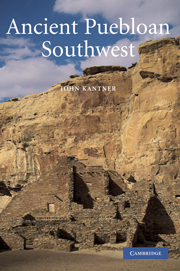Book contents
- Frontmatter
- Contents
- List of figures
- List of boxes
- Acknowledgments
- 1 The ancient Puebloan Southwest: an introduction
- 2 “The Daylight World”: the paleoenvironmental context for Puebloan history
- 3 Return to Ánosin Téhuli? The origins of Puebloan culture
- 4 The wrong Middle Places? Chaco Canyon and the Mimbres Mogollon
- 5 The migrations continue: the end of Chaco and Mimbres
- 6 The AD 1200s: the Great Pueblo period
- 7 The Great Abandonment
- 8 Finding Posi: the protohistoric Puebloan world
- References
- Index
2 - “The Daylight World”: the paleoenvironmental context for Puebloan history
Published online by Cambridge University Press: 05 February 2015
- Frontmatter
- Contents
- List of figures
- List of boxes
- Acknowledgments
- 1 The ancient Puebloan Southwest: an introduction
- 2 “The Daylight World”: the paleoenvironmental context for Puebloan history
- 3 Return to Ánosin Téhuli? The origins of Puebloan culture
- 4 The wrong Middle Places? Chaco Canyon and the Mimbres Mogollon
- 5 The migrations continue: the end of Chaco and Mimbres
- 6 The AD 1200s: the Great Pueblo period
- 7 The Great Abandonment
- 8 Finding Posi: the protohistoric Puebloan world
- References
- Index
Summary
In September 1906, half of the 892 residents of the Hopi Pueblo village of Oraibi moved away as the result of a long-simmering factional dispute (Figure 2.1). Two months later, federal troops forced a large number of the former residents to return, but eventually new villages of Bacavi and Kykotsmovi were established by disenfranchised Oraibi inhabitants. Anthropologists and Hopi alike agree that the “Oraibi split” was one of the more significant events on the Hopi reservation during the twentieth century, and for this reason the Oraibi split has been the subject of anthropological inquiry for many decades. While the facts surrounding the event are fairly well understood, few scholars agree as to the most important causes that culminated in the disintegration of Oraibi. What is clear, however, is that while climate change roughly corresponds with the events of 1906, poor environmental conditions only provided a context for factionalism to reach disruptive levels – the environment did not so much cause the events as it did provide opportunities for them to occur, a perspective that guides interpretations throughout this book.
Oraibi is one of several Hopi villages located on Black Mesa in north-western Arizona (Figure 2.2). Because of the ostensibly desolate and dry environment, historical and cultural change during both pre-Contact and modern periods often have been considered as the result of changing weather patterns.
- Type
- Chapter
- Information
- Ancient Puebloan Southwest , pp. 23 - 51Publisher: Cambridge University PressPrint publication year: 2004



